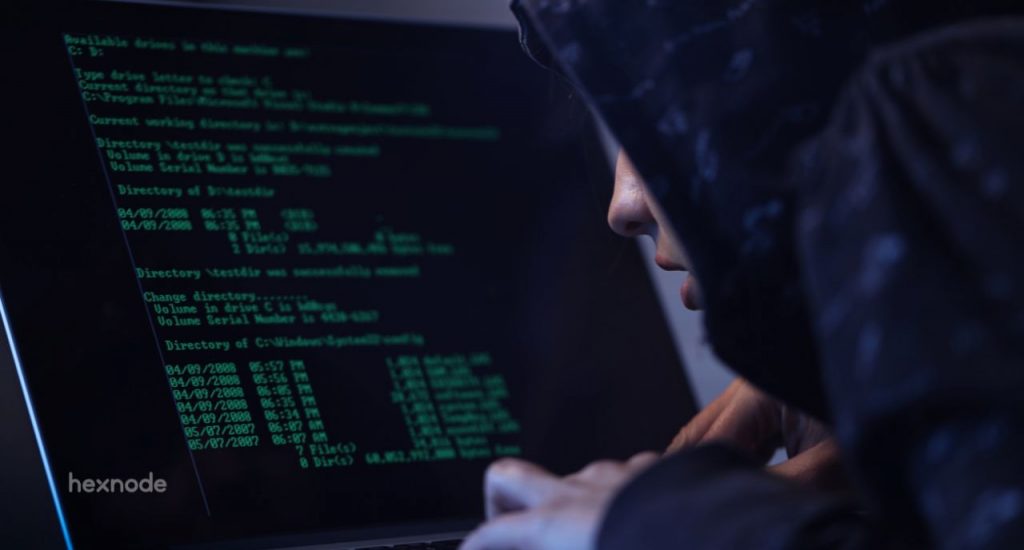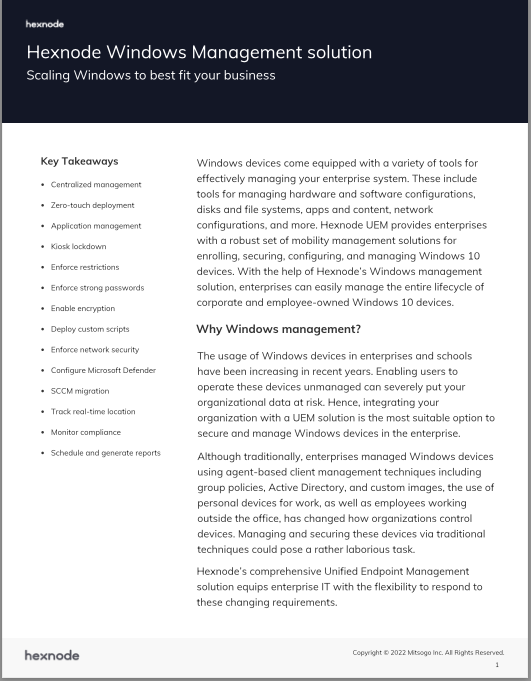BlackLotus malware bypasses Windows Secure Boot: Tips to maximize security
Heard of UEFI bootkits? Well, here's a piece on one that took Windows devices by surprise earlier this year.

Get fresh insights, pro tips, and thought starters–only the best of posts for you.
Alie Ashryver
Jun 23, 2023
15 min read

Who’s the crowd-favorite OS for PCs…….Windows!🎉
Who has the largest market share for desktop OS…….Windows!🎊
Who’s hackers’ favorite OS to attack…….(**cue crickets chirping**)
Whoa! That escalated pretty quick. But the question remains. Which operating system is the target of most of the malware attacks? As popular as Windows is amongst the general public, the sad truth is that it is equally popular among attackers. Any which way you google the attacks, the stats for Windows are always high up. Ransomware, viruses, trojans….you name it. There are tonnes of ways to attack any system. But at the end of the day, they are all malware. And so today, we are talking Windows Malware.
Today, malware has become a pervasive and ever-evolving threat that can wreak havoc on Windows systems. Whether viruses, ransomware, or stealthy fileless malware, these malicious programs pose significant risks to our data, privacy, and system integrity. The consequences of a malware infection can range from data loss and financial damage to compromised security and disrupted operations. It is imperative to understand the importance of malware detection and remediation. Why, you ask? Well, to ensure the safety and security of our Windows systems.
Okay, now that we know the general situation more or less, let us have a look at what exactly we are up against. Let us look at the different types of Windows malware.
Computer systems are as prone to fall prey to viruses as living beings. Much like biological viruses, computer viruses (malicious software) are capable of attaching themselves to the hosts (other files or programs). Designed to self-replicate, they often spread via hacked websites, networks meant for file-sharing, or infected email attachments. Viruses are dormant until a trigger sets them off. Once a trigger activates the virus, it’s a madhouse. They corrupt or delete files and disable critical functions, all the while slowing down the system’s performance.
Yet another type of self-replicating malware, worms, can spread across networks without any human intervention. Exploiting vulnerabilities in networks or operating systems is their go-to method to gain unauthorized access to a target system. Worms can overload network bandwidth, cause system crashes, and create backdoors for other malicious activities. Additionally, they can spread via removable media, instant messaging services, and email attachments.
Trojans are malware that capitalize on misleading users. Posing as legitimate programs, trojans trick the users into running them. They frequently use deceptive emails and bogus software downloads as part of their social engineering strategies. Once executed, Trojans can create unauthorized remote access, steal sensitive data, or enable other malware installations. They can also modify system settings, install keyloggers, or provide unauthorized access to cyber criminals.
Extortion is what this next malware is into. Ransomware encrypts the files on the target system. It then demands a ransom payment in exchange for the decryption key that can decrypt the files on the target system. It often spreads through malicious email attachments, compromised websites, or exploit kits. Ransomware attacks have become increasingly prevalent and sophisticated, targeting individuals, businesses, and even critical infrastructure. The impact of ransomware can be devastating, leading to data loss, operational disruption, and financial loss.
Spyware is a type of malware that is tasked with gathering data on a user’s activity without them knowing about it. It can track keystrokes, monitor browsing habits, capture login credentials, and record personal information. Spyware often works stealthily in the background, transmitting the collected data to remote servers for malicious purposes. It can lead to identity theft, financial fraud, and invasion of privacy.
Adware is a type of malware that displays unwanted advertisements on a user’s system. It often comes bundled with free software downloads or deceptive browser extensions. Adware can generate intrusive pop-ups, inject ads into web pages, and collect user data for targeted advertising purposes. While not inherently malicious, adware can slow down system performance, degrade user experience, and compromise privacy.
Rootkits are stealthy malware designed to provide unauthorized access to a system while concealing their presence from detection. They often modify system files and settings to gain privileged access, thus making it difficult to detect and remove them. Rootkits can be used to install additional malware, manipulate system functions, or maintain persistent control over the infected system.

Get started with Hexnode’s Windows Management solution to improve security, increase productivity, save time and overhead costs of managing your corporate devices.
Download the datasheetIt is not enough to understand the general situation and have our eyes on the lookout for our enemies, Windows malware. As confusing as it sounds, we can’t really be on the lookout for Windows malware unless we are mindful of the up-and-coming trends in Windows malware attacks. And so, that is what we are going to do here.
Fileless malware represents a growing threat in the cybersecurity landscape. They represent a growing threat in the cybersecurity landscape. As we’ve already seen, unlike traditional malware that relies on files stored on the disk, fileless malware operates in memory. They utilize legitimate system tools to carry out their malicious activities. Moreover, by leveraging trusted processes and exploiting vulnerabilities in operating systems and software, fileless malware can evade detection by traditional antivirus solutions. This makes it challenging to identify and mitigate effectively, as it leaves little to no traces on the disk for analysis. This makes it challenging to identify and mitigate effectively, as it leaves little to no traces on the disk for analysis.
Fileless malware can execute malicious scripts or inject code into running processes, allowing it to persistently reside in memory and carry out its harmful objectives. To detect and remediate fileless malware, advanced endpoint security solutions that employ behavior-based detection and memory scanning techniques are required.
Advanced Persistent Threats (APTs) are highly sophisticated and stealthy attacks that specifically target organizations or individuals. APTs involve multiple stages, meticulously planned and executed to gain prolonged access to the target’s systems or networks. Additionally, the attackers often employ advanced techniques, including social engineering, zero-day exploits, and custom-built malware to bypass security defenses.
APTs can remain undetected for extended periods, silently exfiltrating sensitive data, compromising intellectual property, or conducting espionage. Accordingly, detecting and remediating APTs requires a multi-layered security approach that includes proactive threat intelligence, continuous monitoring, and incident response capabilities. And so, organizations must invest in advanced security solutions that provide real-time threat detection, behavior analytics, and network segmentation to minimize the impact of targeted attacks.
The unfamiliar frontier: The dangers of installing apps from unknown sources
As the use of Windows-powered mobile devices continues to grow, malware targeting these devices is on the rise. Malicious apps, infected attachments, and compromised websites pose significant threats to Windows mobile devices. Moreover, mobile malware can steal personal information, track location, send premium-rate SMS messages, or perform unauthorized financial transactions. And so, it is essential to have robust mobile security solutions to detect and remediate malware on Windows devices. These solutions should include application reputation scanning, behavior monitoring, and remote wipe capabilities to protect against mobile malware threats.
With the increasing proliferation of Internet of Things (IoT) devices, Windows systems connected to these devices can become vulnerable to malware attacks. Accordingly, breached smart home devices, compromised routers, or infected surveillance cameras can serve as entry points for malware to infiltrate and infect Windows systems on the same network. Moreover, IoT malware can exploit weak security configurations, default credentials, or software vulnerabilities in IoT devices to gain unauthorized access and propagate across the network.
To detect and remediate IoT malware, securing IoT devices with strong passwords, disabling unnecessary services, and keeping firmware updated is crucial. Additionally, implementing network segmentation and deploying security solutions that monitor IoT device behavior and detect anomalies can help mitigate IoT-related malware threats.
By understanding the emerging trends in malware attacks and their potential impact, Windows users can take proactive measures to enhance their cybersecurity posture. Furthermore, implementing advanced endpoint security solutions, keeping software and devices up to date, practicing safe browsing habits, and educating users about potential threats are essential steps in detecting and remediating the evolving landscape of malware attacks.
Okay, so we know the different malware that can infect our systems, and we also know the emerging trends in Windows malware attacks and their effects. So, the next stage is understanding what a system under malware attack looks like.
Early detection is the key to minimizing damage and preventing further spread when it comes to Windows malware infections. Here are some common symptoms that may indicate your Windows device has been infected with malware:
Windows malware infections can manifest in various ways. Accordingly, they impact the overall behavior and performance of your device. And so, look out for the following signs:
Now we’re getting somewhere! Hexnode, a leading Unified Endpoint Management (UEM) solution, offers powerful features and capabilities to help organizations find and remediate Windows malware effectively. So, let’s explore the various ways Hexnode can assist in combating malware threats:
Hexnode enables granular control over the applications running on Windows devices. Through application whitelisting and blacklisting, you can define a list of trusted applications and block unauthorized or potentially malicious software. By allowing only approved applications to run, Hexnode helps prevent malware from executing on your Windows devices, significantly reducing the risk of infection.
In the event of a severe malware infection or device loss, Hexnode enables remote lock and wipe functionality for Windows devices. Accordingly, this feature allows you to remotely lock down or erase sensitive data from infected devices, preventing unauthorized access to confidential information. By taking swift action, you can mitigate the potential damage caused by malware and safeguard your organization’s data.
It is a full disk encryption feature included in certain editions of the Windows operating system. It provides enhanced security by encrypting the entire hard drive, ensuring that data stored on the drive remains protected even if the device gets lost, stolen, or accessed by unauthorized individuals. Hexnode offers a range of features to centrally manage and enforce BitLocker settings across a fleet of devices to manage BitLocker policies.
Hexnode offers a comprehensive policy for Microsoft Defender, which is a built-in antivirus and anti-malware solution provided by Microsoft for Windows devices. This policy enables administrators to effectively manage and remediate malware attacks on Windows devices through centralized control. Accordingly, Hexnode allows administrators to configure and enforce Microsoft Defender settings across managed devices.
So you see, Hexnode helps you keep Windows malware at bay.
Protecting Windows devices from malware is an ongoing battle in the ever-evolving landscape of cyber threats. The insights gained from recognizing malware symptoms, unusual system behavior, and unwanted pop-ups or redirects can help us take the necessary steps to safeguard our Windows devices and data.
So, stay vigilant, employ a layered security approach, and leverage the power of Hexnode and other advanced security solutions to detect, mitigate, and remediate malware effectively. Remember, the battle against Windows malware is a continuous one. By staying informed, adopting best practices, and utilizing the right tools, we can defend our Windows systems against the ever-evolving threats of the digital landscape.
Stay safe and bye-bye!
Do you want to try Hexnode for all your device management needs? Your 14 day free trial is just a click away.
Join now